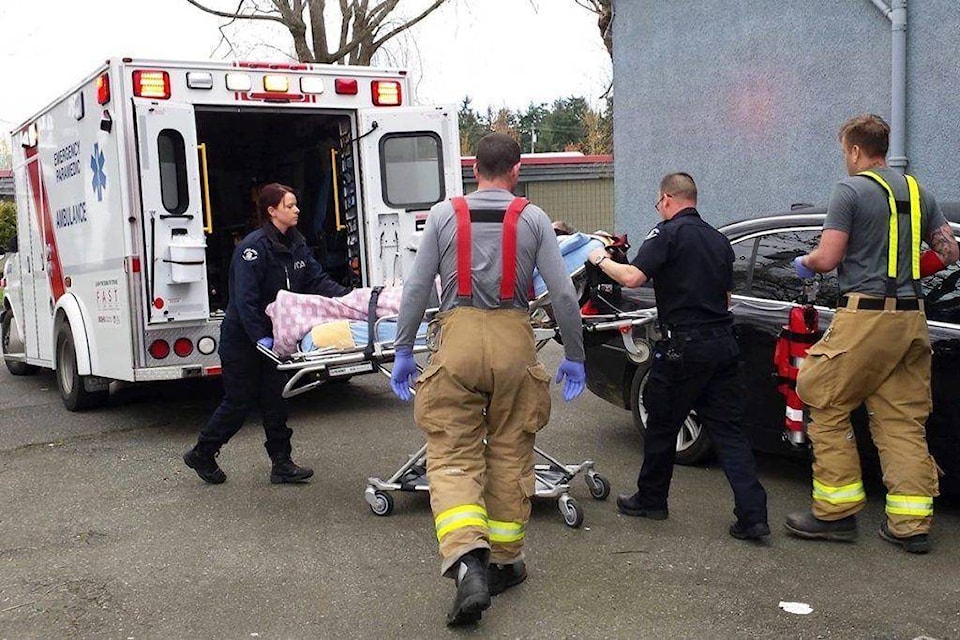While Surrey’s fire chief says the average number of overdose calls is dropping in the city, it coincides with an increased number of deaths — an average of more than 17 per month so far this year.
Len Garis said he agrees with the notion that the decrease in overdose calls could be attributed to overdose-reversing naloxone kits being more readily available.
“We started to see a decline (in calls) in about 2017,” said Garis, noting in all, the department has responded to 5,600 overdoses since 2016. In April and May of last year, the fire department responded to an average of 10.9 overdoses a day. By September, that had dropped to 7, and by October, to 5.
“It’s been fairly steady throughout this year. We’re at about probably 6 to 8 overdoses per day,” said Garis. “But it started to climb in April and May of this year.”
In June, the average number of daily calls dropped once more, to five, and in July Surrey firefighters responded to an average of 6 per day.
While overall drug overdose deaths appear to be on the decline in B.C. this year, compared to last (from 936 as of July 31, 2017, to 878 by July 31 of this year, according to B.C.’s coroner), things aren’t looking as positive in Surrey.
“In Surrey, we ended 2017 with 176 deaths. By the end of July this year, we had 125. That looks like about 17 per month,” said Garis.
“We could exceed last year’s total by as much as 25 or 30 deaths,” if the frequency continues, he noted.
“It’s really disturbing. I can tell you, as a fire department, whether it’s 10 or five or six overdoses we see on an average day, every overdose event we go to, we’re distributing information brochures to individuals, families or victims, to let them know there are other opportunities, and try to encourage a different pathway for those individuals.”
See also: More than 130 people in B.C. died of illicit drug overdoses in July
Garis said a common misconception is that those overdosing are living on the street.
“Of the 5,600 overdose calls we’ve responded to since 2016, 28 per cent of those are within regions that are likely street entrenched. All of the others — more than 70 per cent — are in our neighbourhoods. It’s our friends, our neighbours, all sorts of different circumstances that led them to their overdose, or death.”
As Garis explains, there is a large amount of work being done in Surrey to try to help those who are overdosing: From a partnership with the city, the federal government and Statistics Canada to collect opioid data to create a better understanding of who is overdosing in Surrey and where, to a fire department led initiative that tracks overdose data to identify overdose “clusters.” When there more than three overdoses in a four-hour period within a square kilometre, emergency services and Fraser Health are alerted. That project launched last summer.
See also: Surrey overdose spike caught by fire department ‘cluster’ tracker
See also: Surrey partners with Statistics Canada on opioid data collection
Garis said another study in the works zeroes in on repeat calls for service, using advanced predictive software, for certain variables such as whether weekends, welfare day, certain months or times of year, make a difference in terms of overdose frequency. “If we can get ahead, or as close to the overdose as possible, we can give these individuals a better chance.”
Garis said he’s proud of the work being done, “but I’m not proud we don’t seem to be turning the corner on this particular problem, despite the number of emergency calls declining. But it has not, at least not in this community, reduced the number of deaths. We need to do more about it.
”I’m starting to see some horizons,” he elaborated. “It’s not the horizon we’re looking for, but I can start to see there’s going to be some horizons in terms of understanding who these people are and how we can help them.”
Garis said he’s “painfully aware” of the toll the overdose response calls take on his staff, and all emergency responders.
To show their concern, and support, Surrey firefighters would wear wristbands on Aug. 31, International Overdose Awareness Day. It’s “a very small grain of what the city and Surrey Fire Department is doing to try to support our community in these efforts,” he added.
Other events were held on Friday (Aug. 31) to coincide with International Overdose Awareness Day, including a public event at one of Surrey’s new temporary modular housing sites for the homeless (at 13550 105th Ave.), where politicians and officials were to stress the importance of harm reduction and saving lives amid an ongoing epidemic.
See also: South Surrey vigil aims to remember overdose victims, raise awareness
A candlelight vigil in South Surrey was planned at 7 p.m. Aug. 31 at South Meridian field to remember overdose victims. The event was organized by families of two young adults who died earlier this year from overdoses linked to fentanyl.
